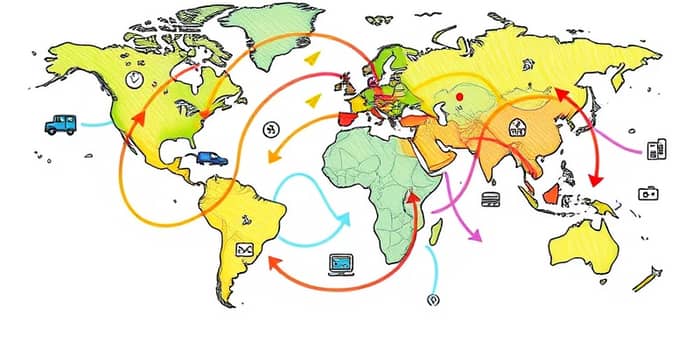
Global commerce has never been more dynamic. As we emerge from historic growth in 2024, fresh data reveals new export champions and evolving strategies. Businesses and policymakers must adapt to seize opportunities in an ever-shifting landscape.
In 2024, global trade soared to an unprecedented $33 trillion, marking a 3.7% increase over the previous year. This surge was driven by a remarkable 9% expansion in services—worth $700 billion—while goods trade grew by 2% ($500 billion). Such diversification highlights the growing significance of the services sector in world commerce.
Developing economies outperformed their developed counterparts, clocking 4% growth for the year and 2% in Q4, propelled by East and South Asia. Meanwhile, developed economies experienced a mild contraction of 2% in the final quarter. Early 2025 data, however, points to a moderation: freight indices have softened, services rose by only 1% and goods by less than 0.5% in Q4. This cooling trend signals the need for agile responses from exporters and importers alike.
Shifts in national standings are reshaping traditional hierarchies. Mexico has maintained its position as the top U.S. trade partner, with total trade reaching $839.9 billion in early 2025. Canada follows at $699.6 billion, led by energy and automotive shipments. China, while still dominant, saw exports rise by just 1.1%, reflecting both structural adjustments and targeted export controls.
A rise in Southeast Asian exporters is evident. Vietnam’s $136.5 billion trade volume underscores its role as a vital link in global supply chains. India, with $118.8 billion in exports, is emerging in pharmaceuticals and IT services. This diversification reduces reliance on any single producer and opens new markets.
Certain industries are at the forefront of export growth. Electronics, vehicles, and semiconductors remain critical for Mexico, Germany, South Korea, Taiwan, and China. Pharmaceuticals and medical supplies fuel surges in Italy, Germany, and India, while Canada’s energy sector benefits from rising crude prices.
Textiles and footwear from Vietnam and India have also gained ground, benefitting from reshoring initiatives and tariff differentials. These shifts underline the importance of agility and innovation in manufacturing and logistics.
Geopolitics is reshaping trade. Export controls have expanded dramatically: the U.S. Entity List grew from 1,350 items in 2019 to over 3,350 by March 2025. Restrictions now target strategic sectors like generative AI, semiconductors, and critical minerals. Other countries, including China, Japan, and the Netherlands, have reciprocated with their own controls, creating a patchwork of regulations.
Tariffs are resurfacing as key tools. Recent U.S. measures on industrial supplies and pharmaceuticals prompted an import rush ahead of anticipated cost hikes. At the same time, the EU’s transition from a trade deficit to a surplus signals resilience, but emerging disputes could test that stability.
To navigate this complex environment, stakeholders must adopt proactive measures. Below are practical steps to capitalize on shifting export opportunities and manage risks:
Policymakers should also streamline customs procedures, invest in port and rail capacity, and support workforce upskilling to ensure national competitiveness.
Despite a potential slowdown, the long-term prognosis for global trade remains positive. Asia is expected to maintain dominance in manufacturing and electronics, but its internal landscape will continue to diversify. Protectionist measures and supply chain fragilities present ongoing challenges, yet they also create opportunities for strategic realignment and deeper regional integration.
Freight volume trends suggest caution—industrial momentum may wane in the short term. However, countries and companies that embrace flexibility, digital transformation, and sustainable practices will be best positioned to lead in the next era of global commerce.
As trade patterns evolve, the fundamental lesson is clear: adaptability will be the cornerstone of success. By leveraging data-driven insights, investing in resilient supply chains, and fostering collaborative trade relationships, exporters can thrive amid shifting export leadership and shifting geopolitical tides.
References













